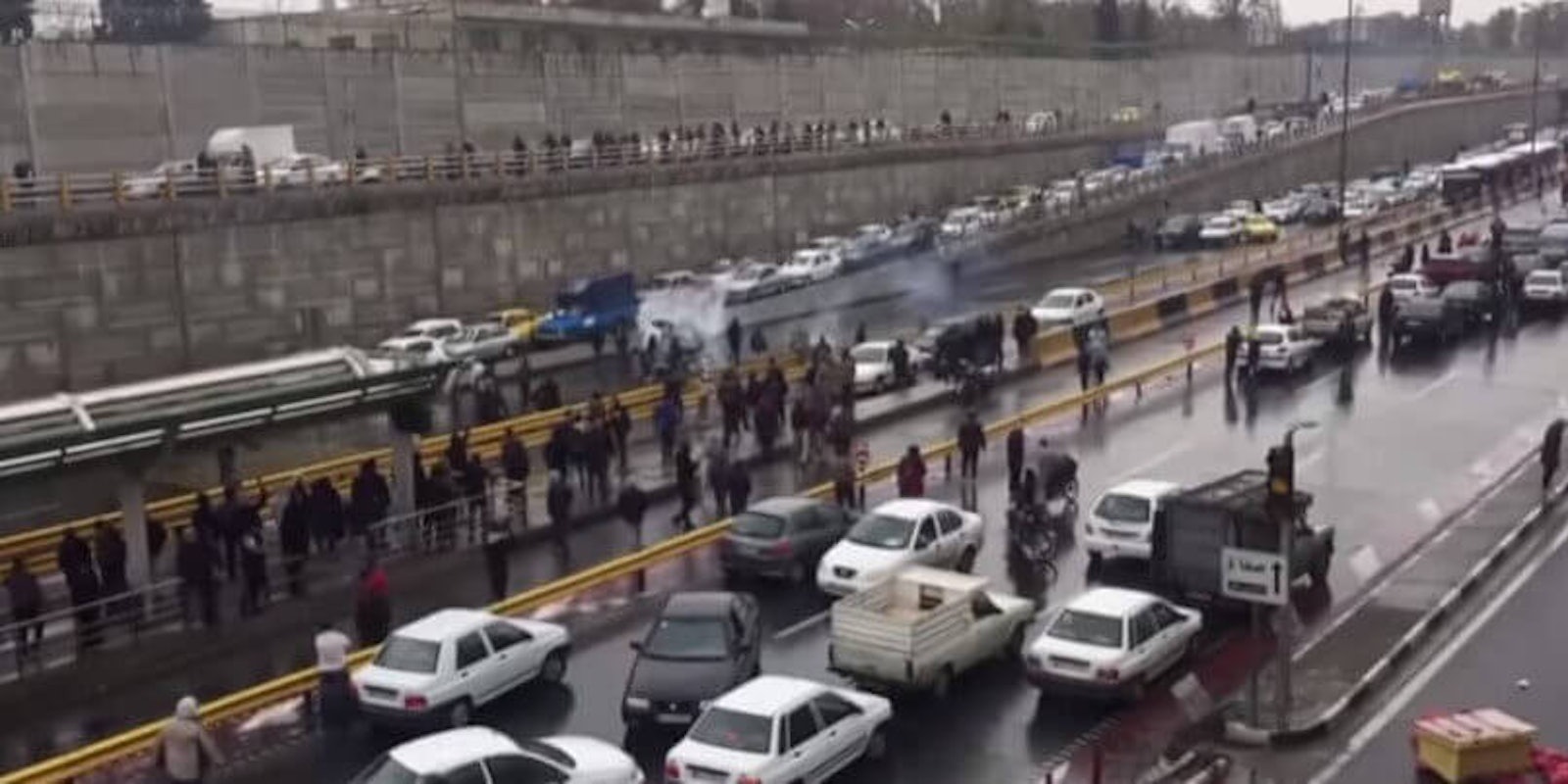In recent days, thousands of Iranians have taken to the streets to protest the government. Twelve deaths and hundreds of injuries have thus far been reported in a wave of unrest across the nation. More than 1,000 have been arrested.
Over the weekend, in an attempt to quell the uprising, Iran announced a near-total blackout of internet access.
The protests are by far the largest the Middle Eastern nation has experienced since 2009. Some report that the number of disgruntled Iranians demonstrating against the government is approaching that seen during the 1979 revolution.
The protests were sparked by steep increases in fuel prices implemented to staunch the economic bleeding caused by U.S. sanctions on Iranian oil. Angry crowds reportedly burned gas stations, banks, statues and photos of the Ayatollah.
Supreme Leader Ayatollah Ali Khamenei blames the unrest on monarchists, foreign interference, and opposition groups seeking to destabilize the nation, the New York Times reports.
The White House publicly supports the protests. Tehran responded by calling the U.S. “hypocritical.”
“It seems weird to see sympathizing with a nation suffering from the US’ economic terrorism and the same person who has already said that the Iranian people should be starved to surrender,” said Iranian Foreign Ministry Spokesman Abbas Mousavi, according to CNN.
Even without internet, protests continue to rage. At present, it seems that discontent is on the rise. Some observers wonder whether the nation is on the brink of revolution.
Writer Shay Khatiri tweeted that the military and police are “very sympathetic” to the people and that some who work within the domestic security apparatus have been sending anonymous supportive messages to the protesters.
https://twitter.com/ShayKhatiri/status/1195860576590868480?s=20
Although the gas price increase inspired the demonstrations, criticisms of the government have mounted in recent years. Some blame the U.S. for sanctions that have crippled the economy, but Iranians are increasingly frustrated with what they view as corruption by the ruling clerics.
Protesters have been heard chanting, “We don’t want an Islamic Republic, we don’t want it, we don’t want it.”
#IranProtests – government shutdown of internet services. Protesters have been killed and its building. Here’s a few clips of cars standing still to protest the hike in gasoline prices. Standing with the people of Iran! https://t.co/iuwewBAaah
— MazJobrani (@MazJobrani) November 18, 2019
Trying to understand the #iranprotest via Twitter is hard enough with gov shutting down the internet.
— Trita Parsi (@tparsi) November 17, 2019
Add to that the army of Saudi funded fake bots and it becomes next to impossible.
(Saudi pitched Trump a $2bn plan to destabilize Iran partly via social media manipulation)
The internet blackout—which Oracle’s Internet Intelligence is calling “the largest internet shutdown ever observed in Iran”—makes it more difficult for protesters to coordinate and stymies the flow of information within and without the country. Yet some images and videos have made their way onto social media.
As of Monday afternoon, more than 40,000 people had viewed a video of protesters handing out flowers to police, saying, “We are not the enemy.”
Another video making the rounds showed a statue of Khomeini’s ring aflame as people reportedly chanted, “Don’t be afraid we are all in this together.” Thousands are tweeting under #IranProtest.
https://twitter.com/DenzDejawon/status/1195789497558011904?s=20
https://twitter.com/Wabi_Sabiiii/status/1196462760319737856?s=20
Demonstraters ar being called for ISIS sympathizers by regime.
— mina bai (@bai_mina) November 18, 2019
Brave Iranian girl standing up to special forces, calling them for ISIS, dressed up like that. "Hit us, come on", says she.#iranprotest pic.twitter.com/9xG422g0PZ
It’s not bravery to open fire on unarmed people who doesn’t want the regime they inherited 40 years ago. Shame on terrorist regime of Mullahs. #IranProtest turn on the volume to hear the shooting sound. pic.twitter.com/6S4SWBC4YL
— Sara_Ghavamian (@saraghavamian) November 18, 2019
#IranProtests
— Iranian American 🇺🇸 (@IranLionness) November 18, 2019
Day 4 of protests
Iran uprising
City of Shiraz
The city looks like a combat area. Major banks are burning! pic.twitter.com/WU6ydW5bwF
People have put the office of Friday’s Prayer Imam on fire. He yesterday did threat people he would unleash his Bassiji Militia to attack people. #Shiraz #IranProtest pic.twitter.com/xFCS4v1sGw
— Sara_Ghavamian (@saraghavamian) November 18, 2019
Images and videos of this nature are precisely the sort of content that the government is trying to suppress by shutting down the internet.
READ MORE:
